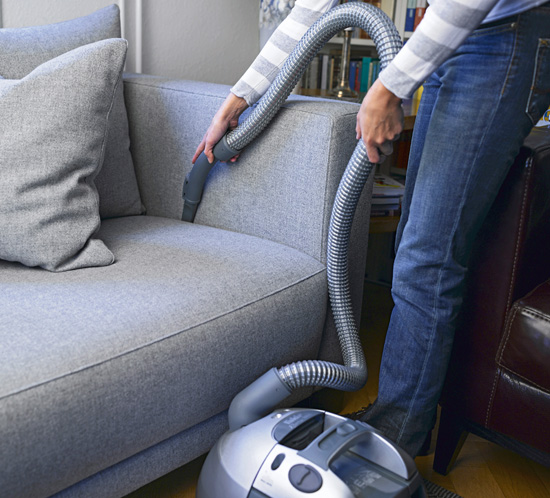
An upholstered sofa in the living room is likely to get slept on, jumped on and have things spilled on it. Given the amount of abuse it takes, maintenance of its upholstery and fabric is important so it looks good and lasts.
It is not surprising that upholstered furniture requires regular care, considering how many hours we spend on the sofa gazing at the television, reading a book or socializing.
• Clean upholstered furniture regularly with the vacuum cleaner, but reduce the suction to avoid damaging the underpadding.
• If possible, beat out the dust outdoors to prevent it from spreading through the room and settling on other furniture.
• Before beating large, upholstered furniture, cover it with a damp cloth to catch the dust being released. If you moisten the cloth with vinegar and water, the colors will look fresher afterwards.
• If chairs have sagged or sofas have indentations where people have been sitting, moisten these pressure points with a little hot water, cover with white paper and iron dry. Just be careful not to burn these spots.
• Clean dirty sofa cushions every year with a solution made from one part vinegar and one part water. Apply it with a cloth and wipe it off with tap water.
• Machine-wash or dry-clean removable covers when necessary. Observe the care directions: Brocade, silk, chintz, velvet and wool tweed, for instance, must be dry-cleaned.
• After washing cushion covers, iron them from the inside and put them back on the cushions while still damp; they will stretch better and dry without wrinkling.
• Rub soiled spots on wool or linen covers with a soft rubber eraser.
• Clean dark velvet upholstery covers with a brush moistened in cold coffee. Then moisten a cloth with tap water and pat the velvet to pick up any excess.
• Clean synthetic covers by dipping a cloth dampened with water in a little baking soda and gently rubbing the cushion with it. Go over it again with a water and soap solution. Test this on the reverse side first (or a corner) to make sure that it doesn’t leave a mark.
• After using water on fabric upholstery, cover the area with paper towels, weight them down and let them dry overnight.
• Remove lint and pet hair with a damp sponge or a piece of adhesive tape wrapped around your hand with the sticky side out.
• Try to train pets from a young age to keep away from upholstery. Leather is least vulnerable to pet damage. Keep cats from scratching upholstery by providing a scratching post. If that doesn’t work, cover vulnerable areas with plastic or attach pieces of old carpet. Cats particularly hate bubble wrap.
USE a CREVICE TOOL to CLEAN BETWEEN the seat and arm of the SOFA.
• Remove residue and vacuum up spills at once. Remove stains by working from the outside towards the middle to avoid leaving an outline.
• Sprinkle fresh grease and oil stains with talcum powder or cornstarch. Let it set to absorb the grease, then brush it off.
• Dab older grease stains with an ammonia solution, rubbing alcohol or cologne, then carefully rub with water.
• Treat milk spots immediately with cold water or a lather of moisturizing soap and lukewarm water. To finish, pat dry.
• Clean washable leather with a soap solution: 1 teaspoon (5 ml) liquid soap in 1 quart (1 L) water. Wring out the cloth thoroughly before wiping the leather. Allow the furniture to dry, then buff.
• Maintain dark leather by rubbing castor oil into it once or twice a year.
• Treat light-colored leather with petroleum jelly. Let it work for about an hour before removing the excess with a soft cloth.
• Restore the shine to scuffed leather upholstery by treating it with a mixture of equal parts beaten egg white and linseed oil.
• For a natural leather polish boil some linseed oil, let it cool and mix with an equal amount of vinegar. Apply with a soft cloth and buff.
• Special nourishing creams for older leather can be purchased at furniture stores or online. Allow them to work their magic for about 24 hours after application, then buff. But make sure you wipe them well so nothing rubs off on clothing.
• Remove water-soluble stains with a damp cloth and moisturizing soap foam; wipe with warm water.
• To treat older grease stains on colorfast leather, dip a cloth into hot water, wring it out, sprinkle on a small amount of baking soda and carefully rub the grease from the edge towards the middle. Go over it with a warm, moist cloth.
• For stubborn dirt or stains, work up a foam with saddle soap and rub it in using a sponge in circular motions. Go over the spot again with tap water and apply leather conditioner after it is dry.
Revitalizing upholstery
2 tablespoons (25 g) soap flakes
2 cups (500 ml) water
1/2 cup (100 ml) glycerin
1/2 cup (100 ml) methylated spirits
Heat the water and dissolve the soap flakes. Let cool and stir in the glycerin and methylated spirits. Store in a container. When needed, dissolve 1 tablespoon (15 ml) of the mixture in water, stir with a whisk and apply the foam with a sponge.
• Pour a little milk on a clean cloth and dab it on leather to help remove marks from a ballpoint pen.
• Sprinkle fresh grease stains with talcum powder. The powder will absorb the grease and you can simply brush it off. Repeat as needed.
• Use an eraser to remove grease stains. But don’t rub for too long or you risk damaging the leather.
• Remove water stains by allowing them to dry, then roughen them with a brush.